This velvety, coconut panna cotta recipe is simple, delicious and impressive! It's a healthy, low-carb twist on Italian panna cotta, made with the most delicious piña colada flavored electrolytes. You'll love this silky, festive no-bake dessert!
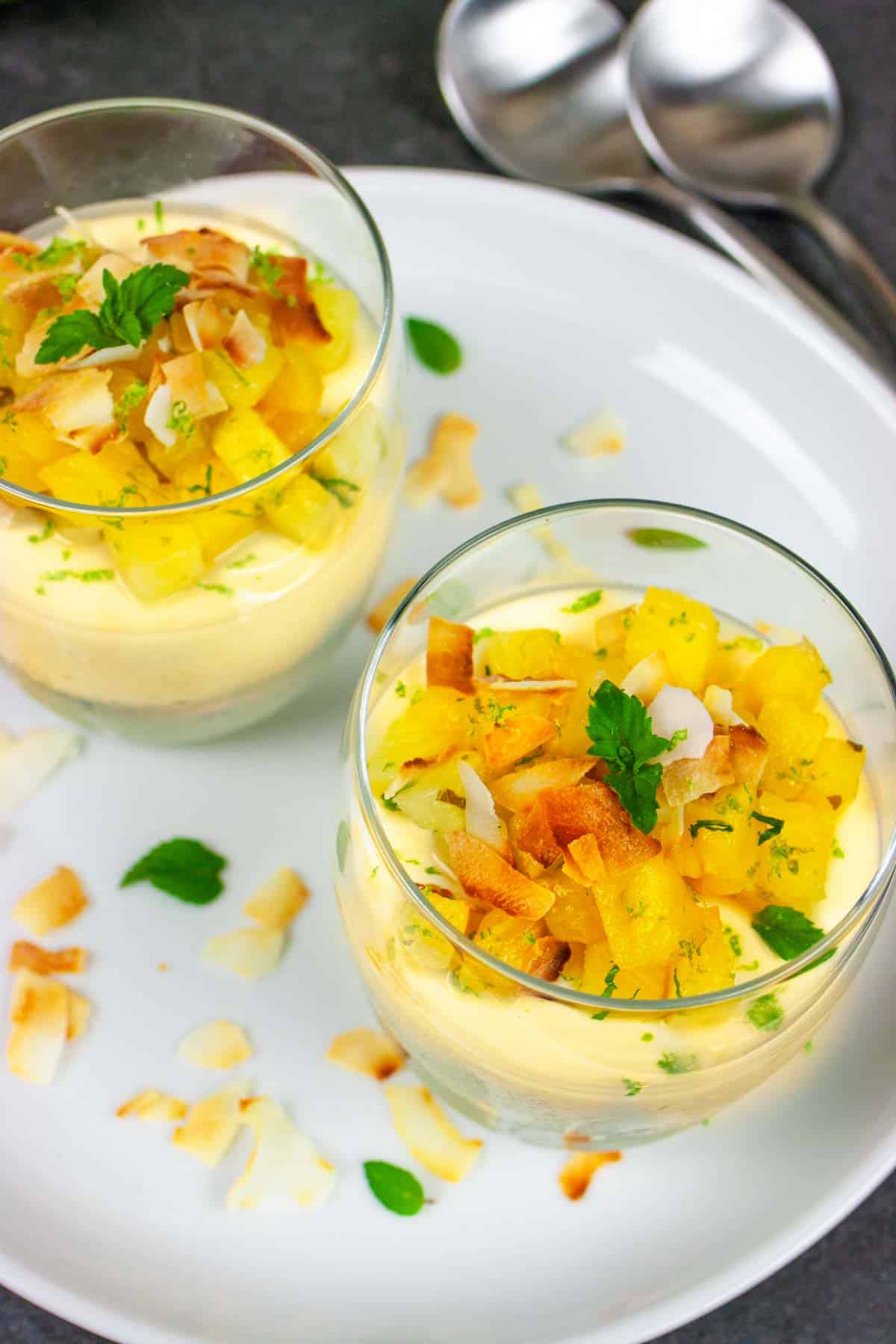
Jump to:
This recipe is like a piña colada mocktail all wrapped up in a silky smooth, rich and creamy glass of bliss - not at all like piña colada jello. We’re talking smooth, sweet custard-like low-carb pudding that's an I-have-no-problem-having-dessert-for-breakfast kind of recipe, like my Keto Eggnog.
Piña colada panna cotta is made with the best electrolytes (in my opinion) that have the most delicious flavors. They're nutritious, naturally flavored and nutritionally well-balanced. And, they're the perfect flavoring for a decadent and healthy dessert. It's a win-win!
This dairy-free dessert is made with coconut milk and toasted coconut that will bring about feelings of tropical paradise.
Why you'll love this recipe
- Incredibly delicious and easy to make – the flavor is simply outstanding and making panna cotta is really very easy
- Sugar-free with all-natural ingredients – this is a healthy dessert recipe, but so indulgent! It's made with natural ingredients and electrolytes that you'll feel good about.
- Special diet friendly – If you love sugar-free desserts and keto sweet snacks, at only 3g net carbs per serving, this is going to make you very happy. This is one of my absolute favorite paleo and low-FODMAP desserts.
What is panna cotta?
In Italian, panna cotta translates to ‘cooked cream’. It’s often served chilled, either straight from the dessert cups or unmolded and inverted onto dessert plates.
Traditionally, this is a popular Italian sweet dessert made with thickened cream and gelatin. Enhance it with fruit, coffee, vanilla or other flavors, then mold or serve in dessert glasses.
I think of it as a cross between jello and custard. It’s slightly sweet and has a creamy, melt-in-your-mouth consistency that makes it very challenging to have just one serving.
Why an electrolyte drink recipe?
My favorite brand of electrolytes (Ultima Replenisher) happens to have very unique Mocktini flavors that include piña colada flavored electrolytes – I don’t think anyone else sells electrolytes that are so good you can cook with them. This variety is so good, I decided to create this stellar ‘coconut-meets-sweet-pineapple-salsa’ healthy dessert recipe.
If you're not familiar with electrolytes or why they're important on a keto diet, read more about these vital nutrients in my post, Importance of Electrolytes on Keto on my Keto Diet Resources page.

Ingredients
You only need a handful of basic ingredients and a packet of delicious electrolytes:
- Full-fat coconut milk – I use full fat canned coconut milk from a brand where the coconut cream doesn’t separate from the milk. Thai Kitchen’s coconut milk stays homogenous and is perfect for pretty much any recipe.
- Sweetener of choice – I use stevia, but any sweetener will work well
- Ultima Replenisher Coconut Piña Colada flavored electrolytes – gives this recipe an amazing piña colada flavor, while enhancing the dessert with vital minerals
- Gelatin – see below for substitutes for gelatin for a vegan option
- Water to bloom the gelatin – cold or room temperature
- Fresh pineapple – chopped into ½ inch cubes
- Lime juice and zest – adds a tangy brightness
- Fresh mint – finely sliced leaves are best
- Rum (optional) – I like to use spiced or Malibu rum
- Shredded coconut or flakes – I use coconut flakes in this recipe, but shredded is also a good option
Is pineapple keto friendly?
Yes, but in small quantities. There are 19g of net carbs in one cup of fresh pineapple. This recipe calls for only ½ cup, which is divided into 4 servings. That makes each portion of the low-carb salsa less than 3g of net carbs.
With the pineapple cut into small pieces, you get to enjoy the bright, fresh citrus without worrying about your macros.
Is pineapple low-FODMAP?
Yes, you can enjoy pineapple on a low-FODMAP diet. One serving is just over 1 cup, but a larger portion is moderate in fructans.
Substitutes for gelatin
To make a vegan panna cotta, there are a couple of very popular options to use in place of regular gelatin:
Agar agar
To make this recipe with agar agar, the steps are similar to using gelatin.
Agar agar is a jelly-like product that is made from the cell walls of algae. It’s a very popular ingredient in vegan pudding, jellies and custards. Available in flakes or powdered, use it in a 1:1 ratio as a gelatin replacement.
Agar agar sets more firmly than gelatin and is less ‘jiggly’. Consider using a little less than the 2 teaspoons of gelatin this recipe calls for if you want the end result to be softer and more like a custard.
Agar agar needs to be simmered to allow it to set. Follow the instructions on the packaging for best results.
Vegan gelatin
Vegan gelatin often contains several ingredients, such as vegetable gum and tapioca dextrin. The ingredients vary by manufacturer, so it’s best to follow the directions on the package for preparation. Typically, the powder is mixed with cold water until its dissolved.
Instructions
Prepare the panna cotta
Bloom the gelatin. I like to do this step while the coconut milk mixture is heating (see next step on preparing the coconut milk mixture).
How to bloom gelatin
This step should be done just before adding the gelatin to your recipe.
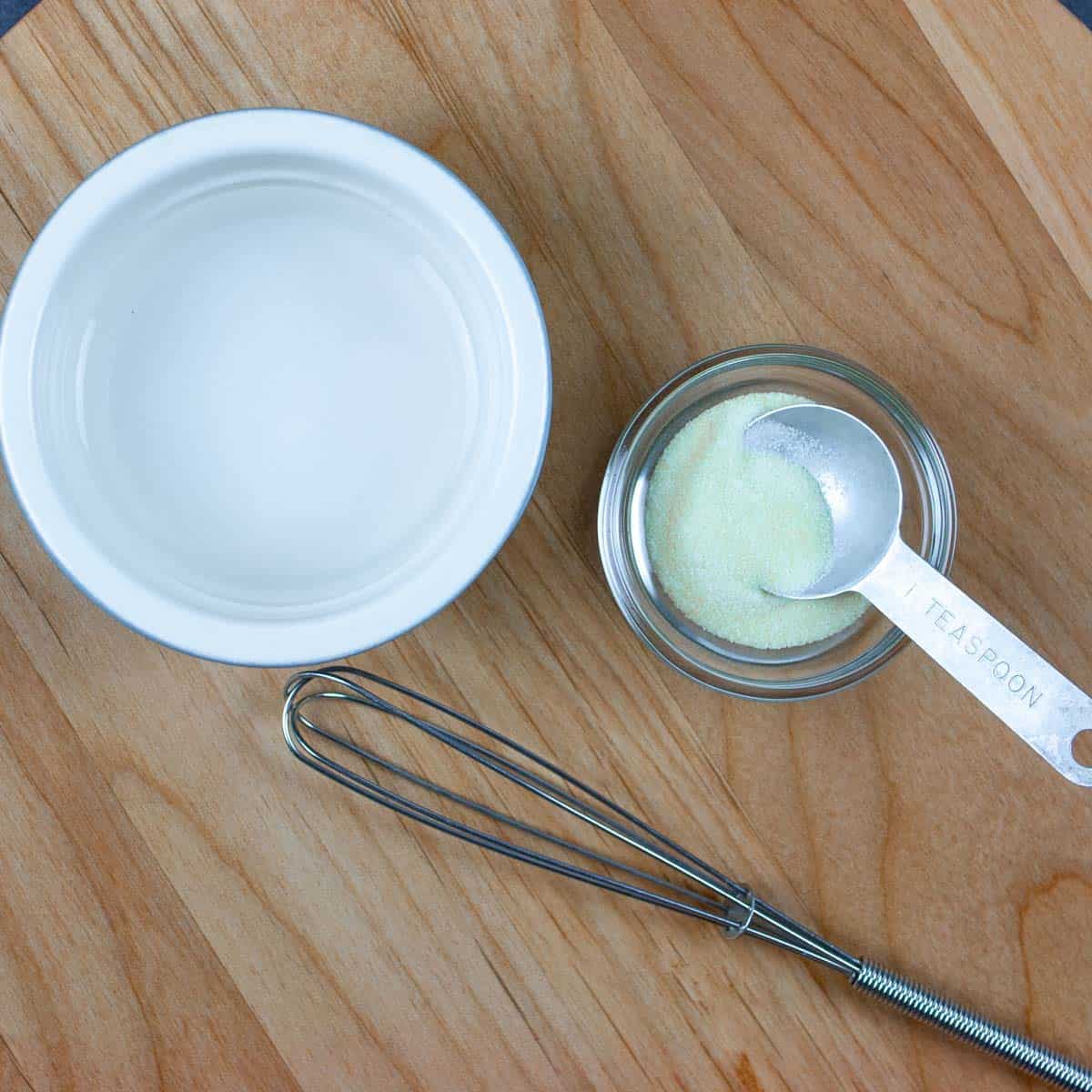
Measure the gelatin and water in preparation for mixing.
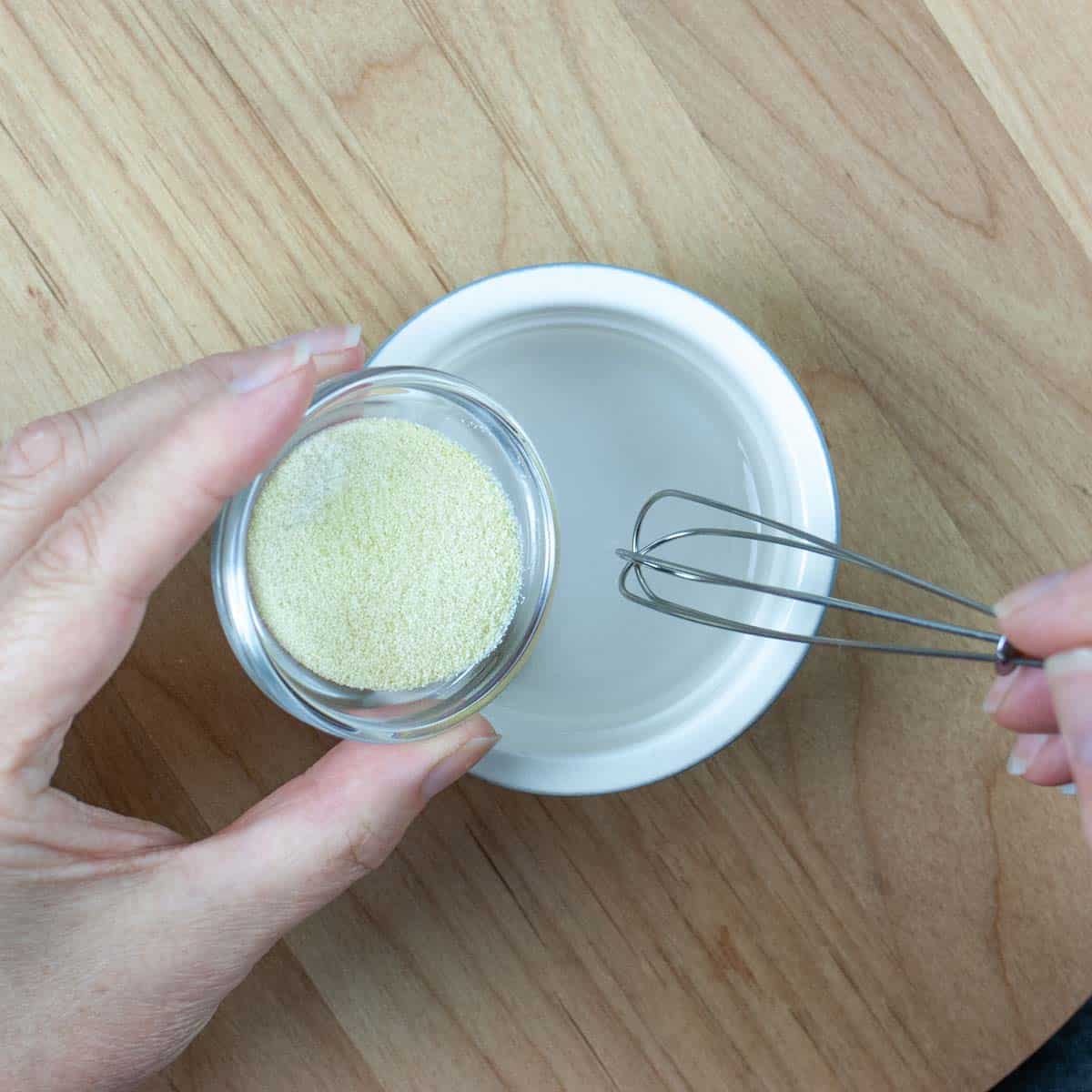
Sprinkle the gelatin into the cold water in a small bowl or ramekin and whisk.
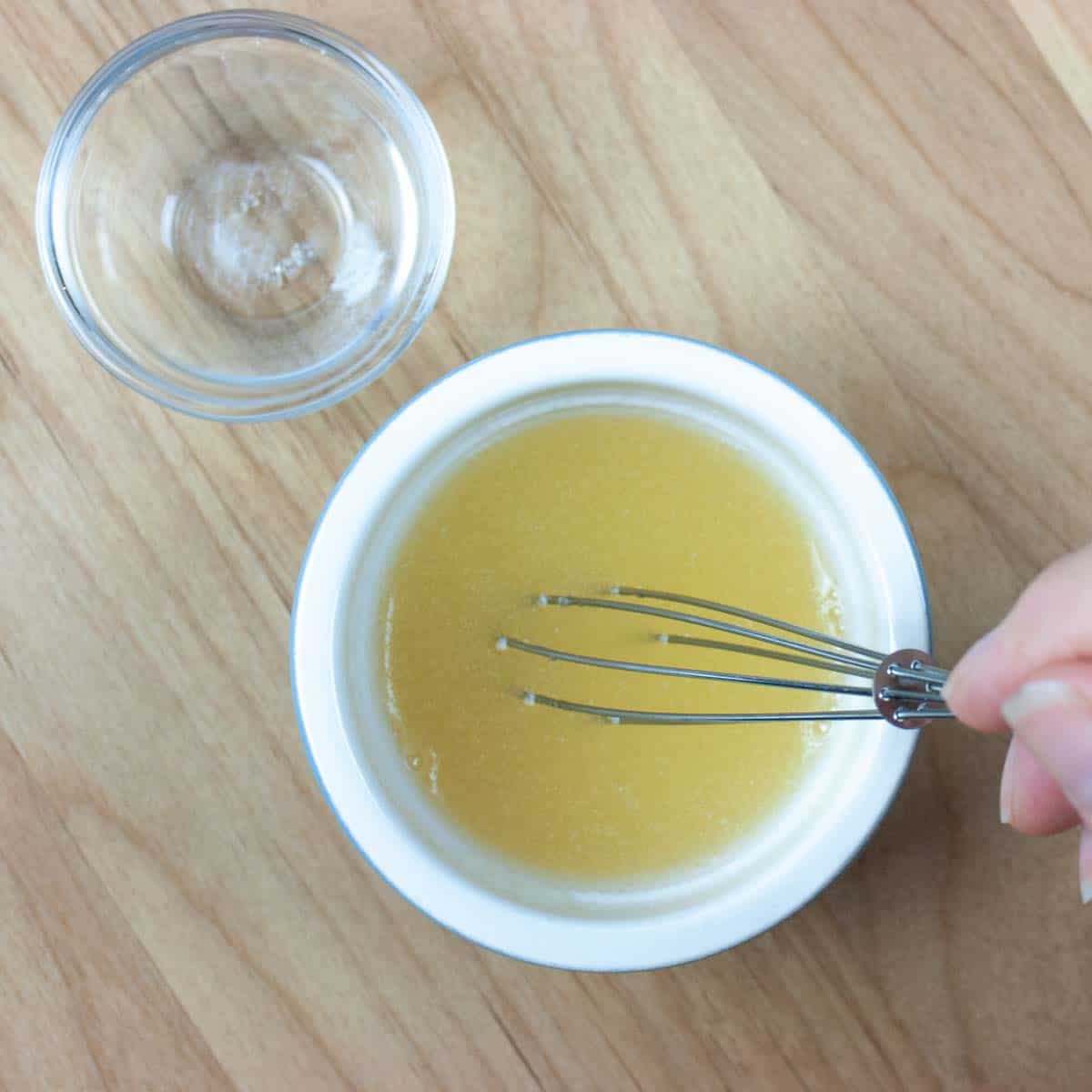
Let the mixture sit for 5 minutes. It will start to swell in size and absorb the liquid almost immediately.
Prepare the coconut milk mixture
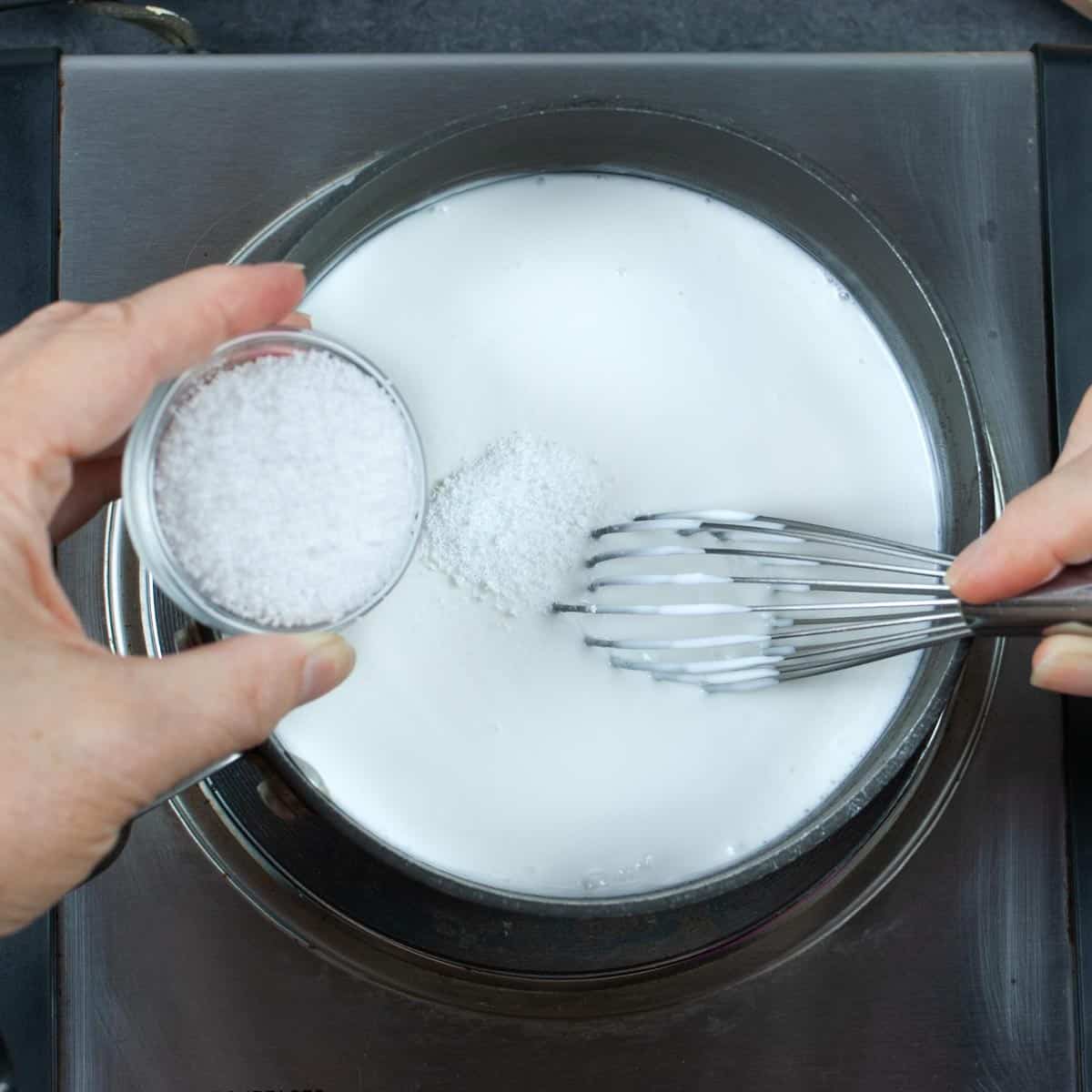
Over medium heat, add the coconut milk to a small saucepan and whisk in 1 tablespoon of sweetener.

When the coconut milk reaches approximately 120°F, add the bloomed gelatin mixture to the saucepan and turn off the heat. Gently whisk until thoroughly dissolved.

Add one Coconut Piña Colada electrolytes stickpack (or 1 teaspoon) and whisk until thoroughly combined.
TIP: The best way to gage the temperature of the coconut milk is to use an instant read thermometer or a candy thermometer to test the temperature. If you don’t have a thermometer, you can estimate the temperature. The coconut milk should not be boiling. When you start seeing tiny bubbles forming on the side of the pot or a light steam, it’s hot enough.
TIP: Gelatin loses its ability to set if boiled. The maximum temperature of your liquid should be no higher than 150°F or your finished recipe may not set appropriately.
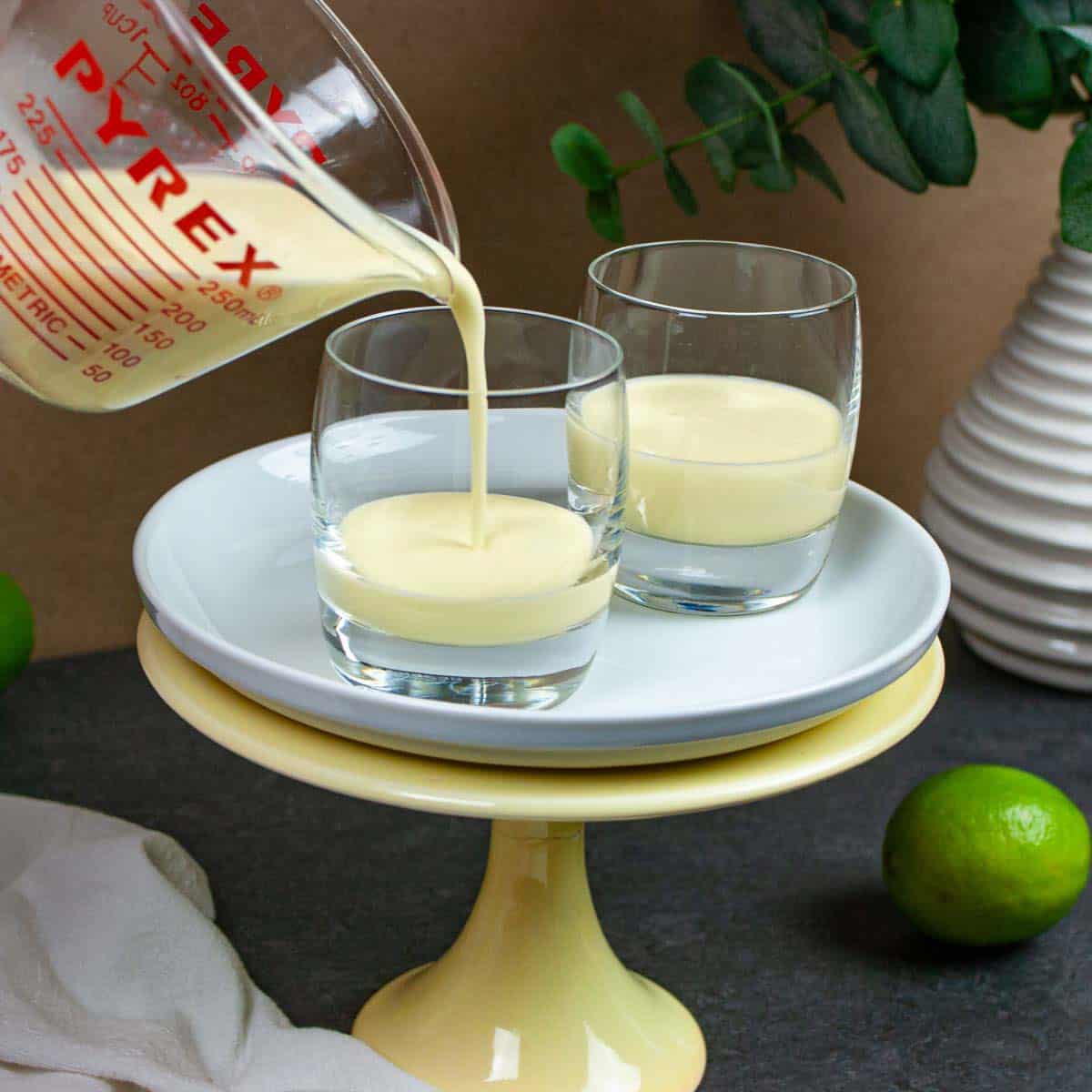
Pouring the mixture
Pour the mixture into dessert cups, verrine glasses or mold of choice.
If using molds, be sure to lightly oil the inside of the mold to prevent the pudding from sticking to the sides.
Chill until set: Cover and refrigerate until set, at least 4 hours.
TIP: Depending on the cups or glasses being used, it may be best to cool the mixture before pouring into the glasses. You can let it cool in the pan or place the saucepan in an ice bath until cool to the touch.
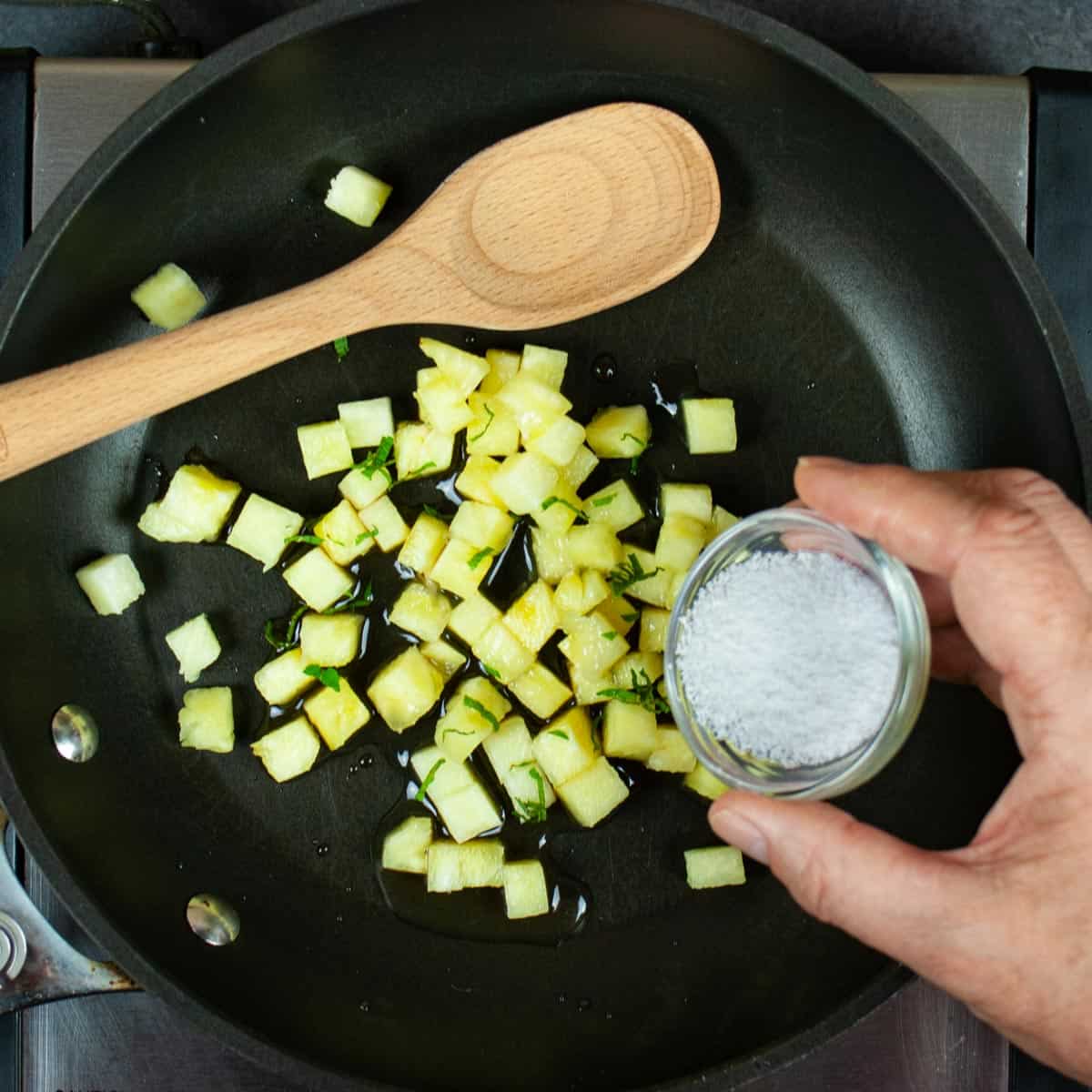
Prepare the topping
While the pudding is chilling, make the pineapple salsa and toasted coconut. Both of these can be made ahead of time and stored separately until serving.
Make the pineapple salsa
In a small sauté pan, add the lime juice, rum (if using), chopped pineapple and 1 tablespoon of sweetener.
Simmer on medium heat for about 2 minutes, until most of the liquid has evaporated and the pineapple chunks are slightly soft.
Turn off the heat and add the finely sliced mint leaves and lime zest, reserving a small amount of each for garnish.
If not using immediately, store in the refrigerator in a sealed container until ready to use. I use any leftover pineapple to make a delicious Pineapple Habanero Salsa.
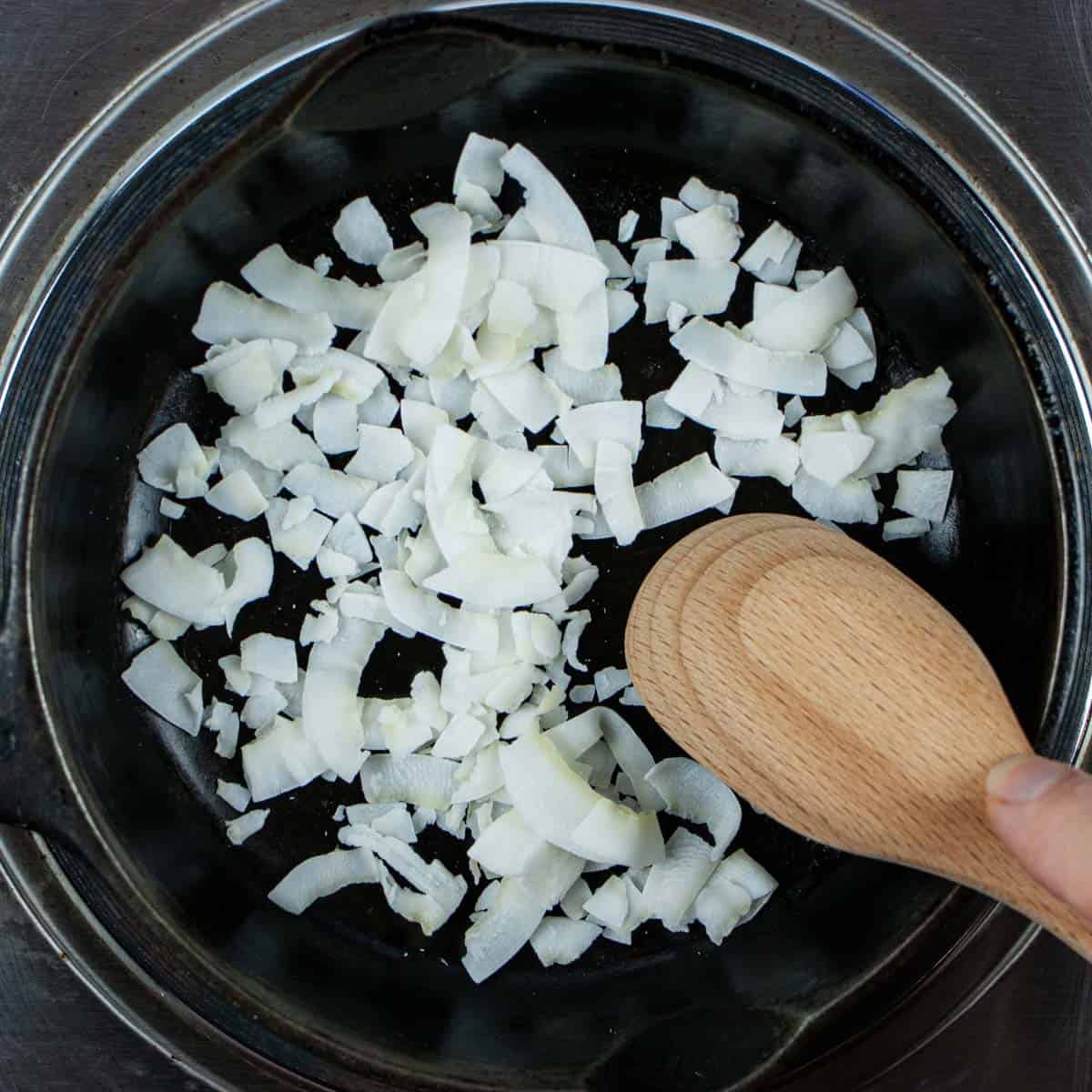
In a small un-oiled sauté pan, add the shaved or shredded coconut.
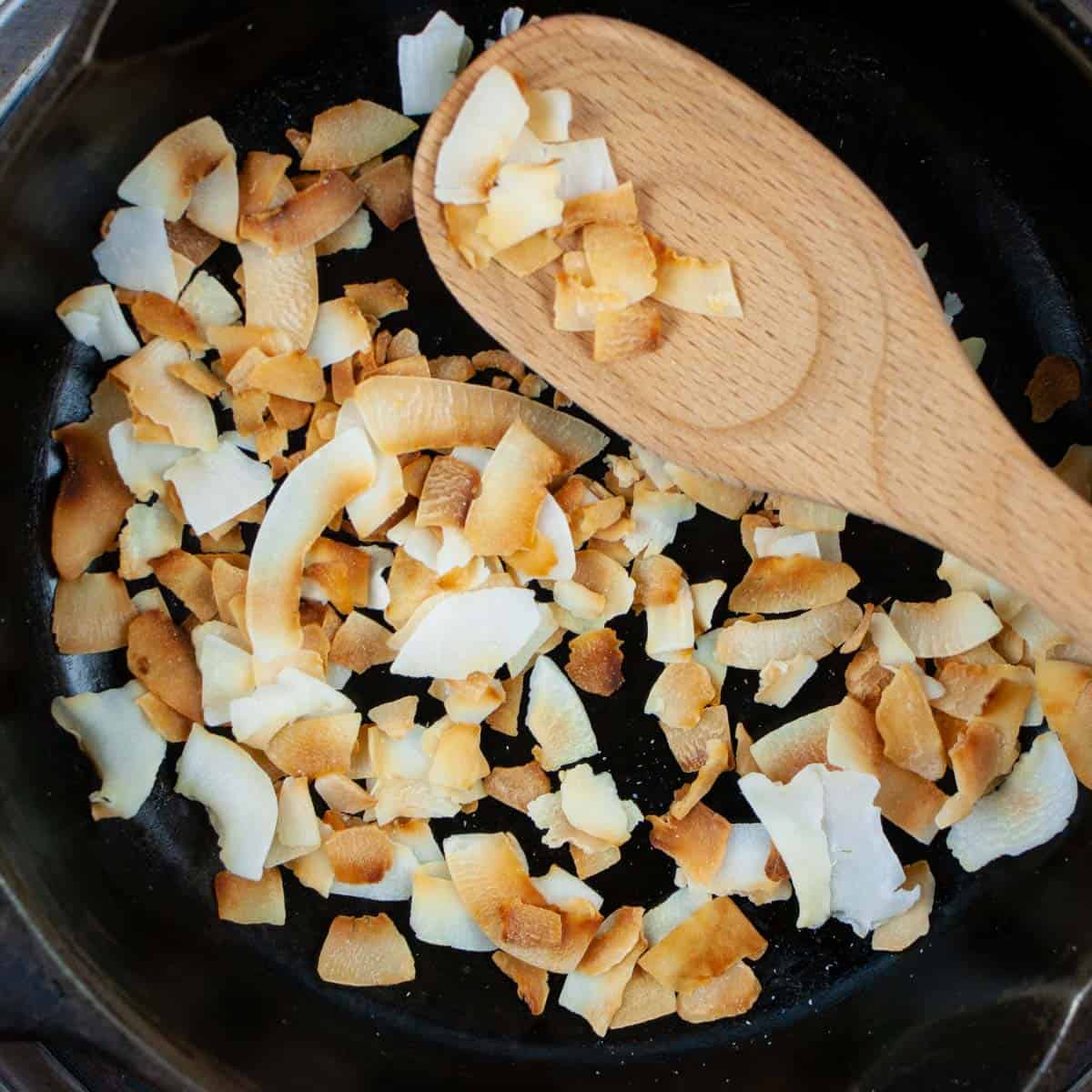
Sauté on medium heat until slightly browned, stirring frequently.
Toast the coconut
Coconut toasts very quickly, so don’t leave the pan unattended! Once cooled, store in a sealed container at room temperature until ready to use.
How to serve
When using dessert cups or glasses, you can serve directly from the cups.
Once set, it's ready to serve:
- Spoon ¼ of the pineapple salsa into each of the cups or glasses or spoon on top of your unmolded dessert
- Top with toasted coconut and sprinkle with some reserved sliced mint leaves and lime zest for garnish
If you’ve used a mold or ramekin and want to serve on a plate:
- Dip the mold or ramekin in hot water for about 10 seconds, making sure no water flows over the top
- Gently use your fingertip to pull the panna cotta away from the sides
- Invert onto a dessert plate and gently tap the sides to unmold
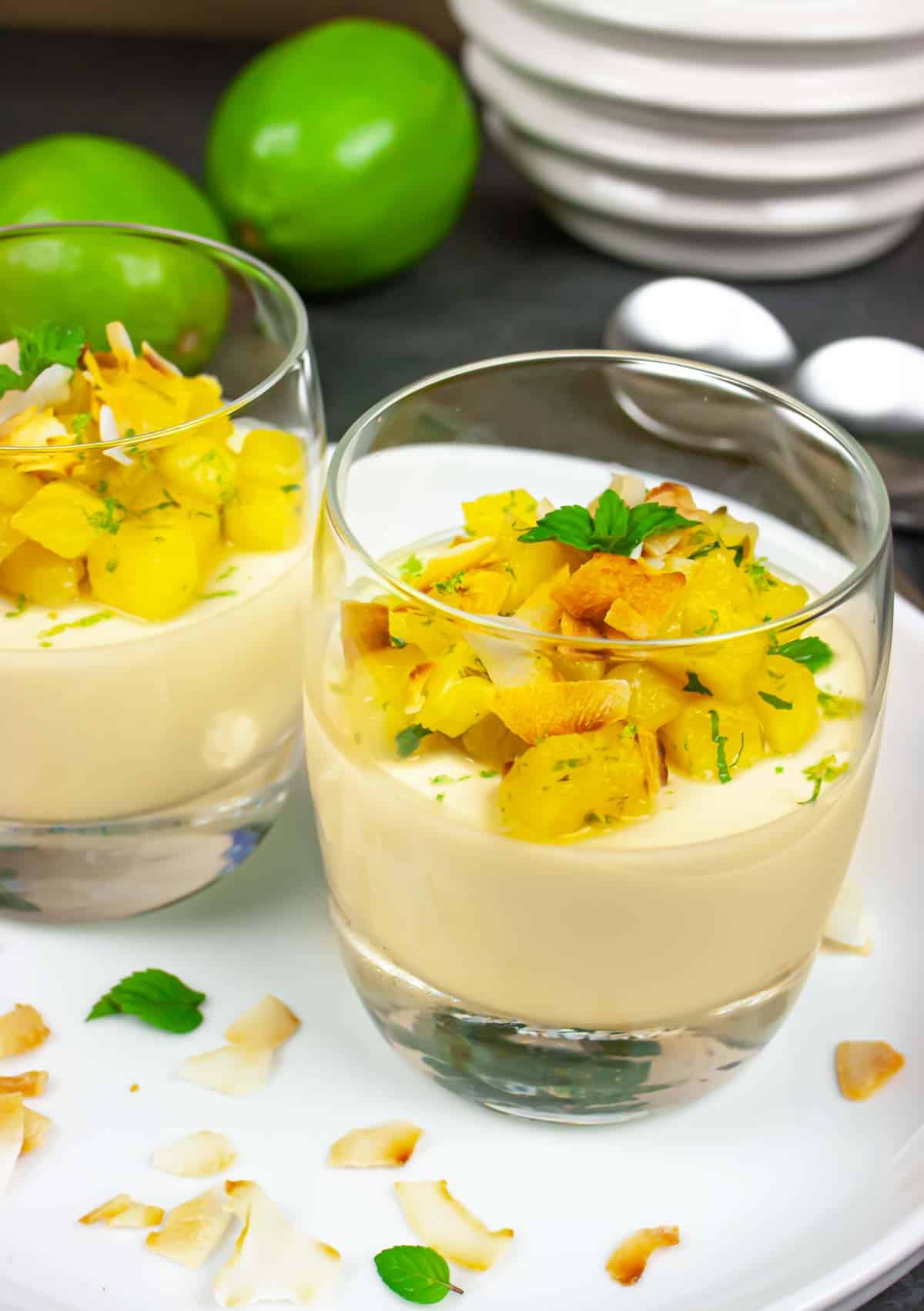
Variations
- Vegan panna cotta – replace the gelatin with agar agar or another gelatin substitute for a vegan gelatin replacement.
- Passionfruit panna cotta – Ultima Replenisher has a passionfruit electrolyte powder that’s perfect for this recipe. Simply use it in place of the Coconut Piña Colada variety.
- Add some heat – If you like a little (or a lot) of spice, try adding some very finely chopped aji pineapple, jalapeño or habanero peppers to the salsa. Pineapple habanero salsa would be amazing with the sweet creamy texture of the dessert.
- Piña colada pudding – to make a decadent softer piña colada coconut pudding or custard, simply use half the amount of gelatin
More expert tips
- Don’t skip blooming the gelatin – in order to get a perfect, silky consistency, it must be bloomed in water first
- Don’t add the gelatin if your mixture is too hot – if gelatin is overheated or boiled, it will not set properly. Overheating weakens its setting strength.
- Avoid speeding up the setting process – don't put it in the freezer. The setting process is time dependent rather than just temperature dependent.
- Store your dessert in the refrigerator – until ready to serve. As it warms up, the consistency will soften.
FAQ
Coconut milk has a very low glycemic load. It is very low in carbohydrates and has a high fat content, making blood sugar spikes unlikely.
Gelatin is high in amino acids and is almost a complete protein by itself. When hydrated, it is an excellent source of bioavailable protein, which means it takes almost no energy to digest. It is a great source of amino acids and collagen, which is beneficial for the skin, joints, bone health and digestion.
Gelatin should be bloomed in cold or room temperature water. If it’s bloomed in hot water, the outside of the granules swell too quickly, which prevents water from penetrating the center. Its strength declines when bloomed in liquids that exceed temperatures above about 150°F. After it’s bloomed, it can be added to hot water, but may lose its gelling capacity if boiled.
It depends on the recipe. Try freezing a small portion and defrosting before freezing an entire batch. The liquids and solids may separate when defrosting, so it’s best to test the recipe by initially freezing only a small amount.
Make sure you freeze your dessert in a freezer-safe container, as dessert glasses may not hold up to freezing temperatures.
You can prepare your dessert up to 3 days before serving. Be sure to store it covered so it doesn't absorb odors in the refrigerator.
Did you make this recipe? Let me know how you liked it by giving a star rating and leaving a comment!
📖 Recipe

Piña Colada Panna Cotta with Pineapple and Lime
Ingredients
- 2 cups full fat coconut milk
- 2 tablespoons powdered stevia (or use sweetener of choice)
- 1 teaspoon Ultima Replenisher Coconut Piña Colada electrolyte powder (or 1 stickpack)
- 2 teaspoons gelatin (see post for vegan gelatin substitutes)
- ¼ cup cold water
- ½ cup pineapple (cut into ½ inch cubes)
- 1 tablespoon lime juice
- 1 tablespoon rum (optional)
- 2 teaspoons mint leaves (finely sliced)
- 1 lime (zest only)
- ¼ cup dried flaked coconut (or shredded coconut)
Instructions
To prepare the pudding mixture:
- In a small saucepan, heat the coconut milk over medium heat and whisk in 1 tablespoon sweetener until dissolved.
- Add the cold water to a small, shallow bowl and sprinkle the gelatin over the top. Whisk until all granules are moistened and let sit for 5 minutes.
- When the coconut milk is hot, not boiling (about 120-150°F), add the bloomed gelatin to the saucepan and turn off the heat. Gently whisk until thoroughly dissolved.
- Add the Coconut Piña Colada electrolyte powder and whisk until dissolved.
- Pour the mixture into 4 dessert glasses, cups or molds.
- Refrigerate for at least 4 hours, or until set.
To prepare the pineapple salsa topping:
- In a small sauté pan, add the lime juice, rum, chopped pineapple and 1 tablespoon of sweetener.
- Simmer on medium heat for about 2 minutes, until most of the liquid has evaporated and the pineapple chunks are slightly soft.
- Turn off the heat and add the finely sliced mint leaves and lime zest, reserving a few pinches of each for garnish.
- If not using immediately, store in the refrigerator in a sealed container until ready to use.
Toast the coconut:
- In a small un-oiled sauté pan, add the shaved coconut.
- Sauté on medium heat until slightly browned, stirring frequently.
Assemble the dessert:
- Spoon ¼ of the pineapple into each of the cups or glasses or spoon on top of your unmolded dessert.
- Top with toasted coconut and sprinkle with some reserved sliced mint leaves and lime zest for garnish.
Notes
Expert tips
- The best way to gage the temperature of the coconut milk is to use a thermometer to test the temperature. If you don’t have a thermometer, you can estimate the temperature. The coconut milk should not be boiling. When you start seeing tiny bubbles forming on the side of the pot or a light steam, it’s hot enough.
- Gelatin loses its ability to set if boiled. The maximum temperature of your liquid should be no higher than 150 degrees Fahrenheit or your finished recipe may not set appropriately.
- If using molds, be sure to lightly oil the inside of the mold to prevent the pudding from sticking to the sides
- Depending on the cups or glasses being used, it may be best to cool the mixture before pouring into the glasses. You can let it cool in the pan or place the saucepan in an ice bath until cool to the touch.
- Don’t skip blooming the gelatin. In order to get a perfect, silky consistency, it must be bloomed in water first.
- Don’t add the bloomed gelatin if your mixture is too hot. If gelatin is overheated or boiled, it will not set properly. Overheating it weakens its setting strength.
- Don't try to speed up the setting process by putting it in the freezer. The setting process is time dependent rather than just temperature dependent.
- Store your dessert in the refrigerator until ready to serve. As it warms up, the consistency will soften.
Nutrition
*Net carbs = carbohydrates - fiber
Nutritional information is an estimate, calculated using online tools and does not include optional ingredients unless otherwise indicated.

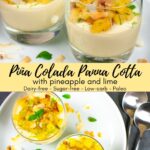
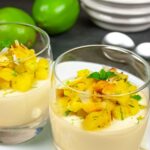

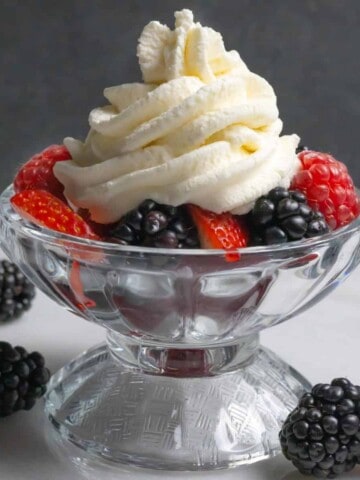
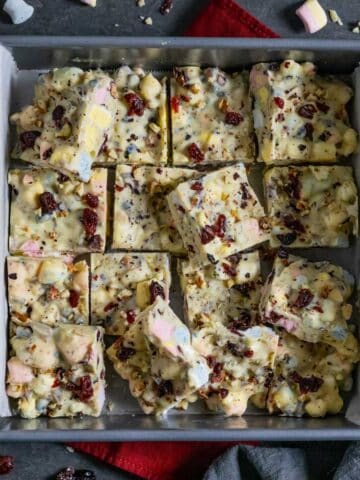
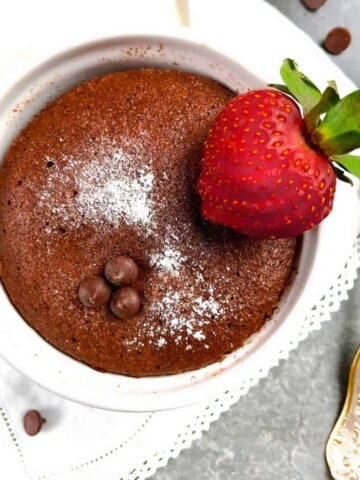
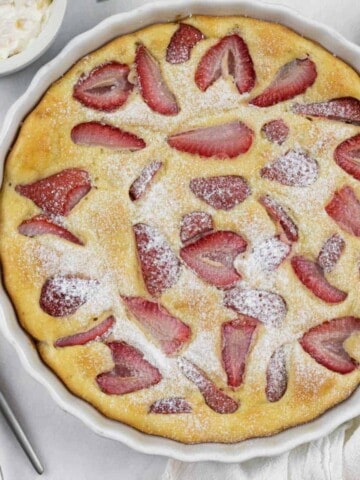
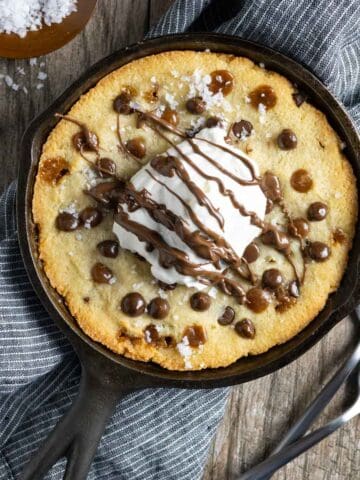
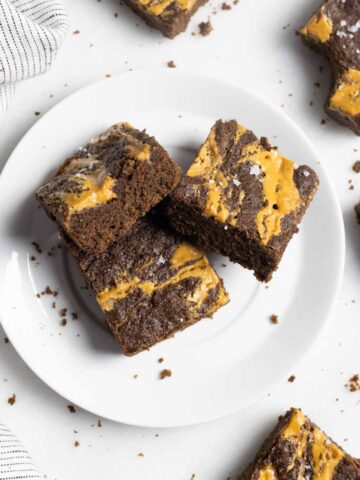
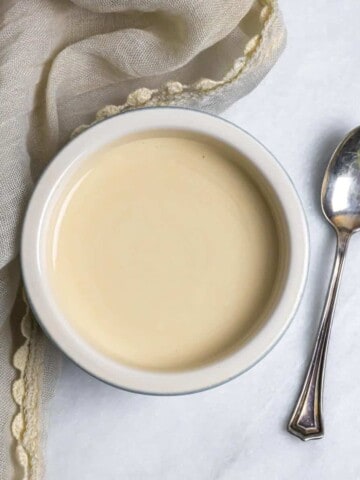
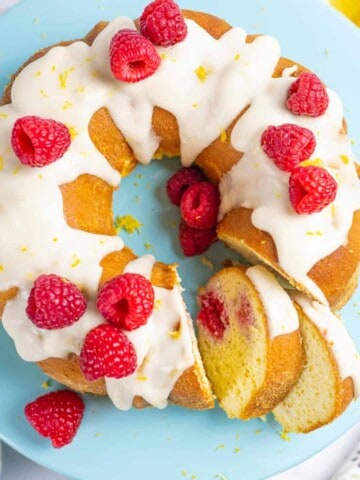
Comments
No Comments